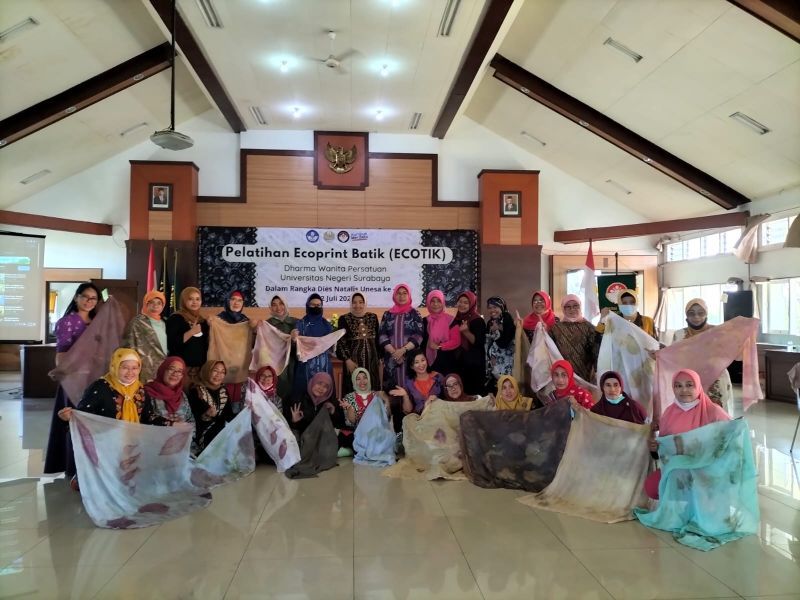
www.unesa.ac.id
Unesa.ac.id, SURABAYA - The women, both lecturers and education staff, seemed enthusiastic about participating in the Ecoprint Batik training held by Dharma Wanita Persatuan (DWP) State University of Surabaya (UNESA) at the Auditorium, 4th Floor, Faculty of Engineering Building, Ketintang Campus on Friday, 22 July 2022.
Ecoprint is a type of batik making by trimming plants into the fabric to create the desired color and pattern. The principle of manufacture can be through direct contact between leaves, flowers, stems or other body parts of plants that contain color pigments with certain fabric media.
Dra. Urip Wahyuningsing M.Pd., UNESA Vocational Lecturer and presenter said that ecoprint is always evolving, which was previously only ponding and steaming, then now new, more sustainable techniques have emerged that utilize nature so as not to pollute the environment.
"In making environmentally friendly designs, ecoprint not only uses leaves that are still fresh, but also leaves that have fallen. Leaves that are dry and cannot produce color can be treated to bring out color," he said.

www.unesa.ac.id
The fabric media used for ecoprint has special criteria, one of which is cotton, paris, and most importantly natural fibers so that color absorption is faster. The resulting motifs can vary based on the leaf pattern used.
"Motives can be made in various ways. It doesn't have to be neat or parallel. It can also be skewed and random. In fact, it can produce aesthetic motifs," he explained.
There are several things that need to be considered in making ecoprint batik. First, the selection of fabrics recommended for natural fibers or silk and wool types. The more natural fiber the better. Second, use the type of leaf. Leaves that do not produce color can be treated by dipping them in water with a vinegar mixture. Third, at the time of rolling between blangkat and the main ingredient must be sticky.
The method of making ecoprints is quite simple. The cloth is dipped in water mixed with lime and vinegar. Then opened and affixed leaves on it. If the type of leaves can not produce color, then the leaves are dipped in vinegar solution water. After that it is covered again with cloth and covered with plastic and rolled up.
The cloth is then cooked for 1-3 hours for maximum results. After that enter the drying stage for 7 days. It is better if the cloth is not washed first. Simply dry in a place that is not exposed to direct sunlight.
After the presentation of the material, the participants immediately practiced making their own version of ecoprint batik. The results are then judged by the team in several categories. For the arrangement of the best color balls, it falls on Yulianto's work.
"It's really fun because this ecoprint is new. This can be a useful activity to fill spare time. After all, the results can be sold or become gifts. I'm very happy, especially when I get a gift. assisted by others. My hope is that I can try again to make ecoprints from other objects," said Mutmainnah, the participant who won second place in the abstract motif category.
Chairperson of the UNESA DWP, Dra. Endah Purnomowati Nurhasan M.Pd., hopes that women at UNESA understand and are skilled in batik, especially ecoprint. From these skills, of course in the future it is possible to open a business or those who already have a business can add skills in producing more innovative and aesthetic ecoprints. (UNESA PR)
Author: Nisvi
Editor: @zam Alasiah*
Photo: Photo documentation of Unesa Public Relations reporter
Share It On:






